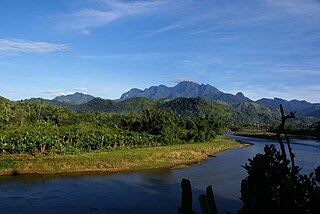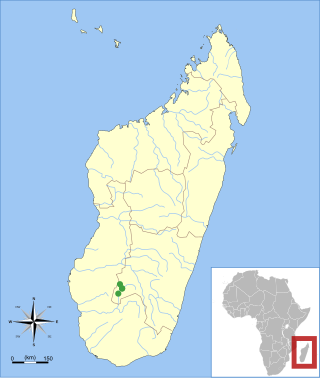
Madagascar, officially the Republic of Madagascar is a sovereign island country in the Indian Ocean, approximately 400 kilometres off the coast of East Africa across the Mozambique Channel. At 592,800 square kilometres (228,900 sq mi), it is the world's second-largest island country, after Indonesia. Its capital and largest city is Antananarivo.

The ecoregions of Madagascar, as defined by the World Wildlife Fund, include seven terrestrial, five freshwater, and two marine ecoregions. Madagascar's diverse natural habitats harbour a rich fauna and flora with high levels of endemism, but most ecoregions suffer from habitat loss.

The Madagascar Plan was a plan to forcibly relocate the Jewish population of Europe to the island of Madagascar which was proposed by the Nazi German government. Franz Rademacher, head of the Jewish Department of the German Foreign Office, proposed the idea in June 1940, shortly before the Fall of France. The proposal called for the handing over of control of Madagascar, then a French colony, to Germany as part of the eventual peace terms.

Rajasaurus is a genus of carnivorous abelisaurid theropod dinosaur from the Late Cretaceous of India, containing one species: Rajasaurus narmadensis. The bones were excavated from the Lameta Formation in the Gujarat state of Western India, probably inhabiting what is now the Narmada River Valley. It was formally described by palaeontologist Jeffrey A. Wilson and colleagues in 2003 based on a partial skeleton comprising the braincase, spine, hip bone, legs, and tail–a first for an Indian theropod. The dinosaur likely measured 6.6 metres (22 ft), and had a single horn on the forehead which was probably used for display and head-butting. Like other abelisaurids, Rajasaurus was probably an ambush predator.

The bushpig is a member of the pig family that inhabits forests, woodland, riverine vegetation and cultivated areas in East and Southern Africa. Probably introduced populations are also present in Madagascar. There have also been unverified reports of their presence on the Comoro island of Mayotte. Bushpigs are mainly nocturnal. There are several subspecies.

Madagascar: Escape 2 Africa is a 2008 American computer-animated adventure comedy film produced by DreamWorks Animation and Pacific Data Images and distributed by Paramount Pictures. It is the sequel to Madagascar (2005) and the second installment in the franchise. It was directed by Eric Darnell and Tom McGrath, with a screenplay written by Etan Cohen, Darnell, and McGrath, and features Ben Stiller, Chris Rock, David Schwimmer, Jada Pinkett Smith, Sacha Baron Cohen, Cedric the Entertainer, Andy Richter, Elisa Gabrielli, McGrath, Chris Miller, Christopher Knights, and Conrad Vernon reprising their voice acting roles from the first film, joined by new cast members Bernie Mac, Alec Baldwin, Sherri Shepherd, and will.i.am. In the film, the main characters—a party of animals from the Central Park Zoo whose adventures have taken them to Madagascar—find themselves in Africa, where they meet others of their species and where Alex the lion reunites with his parents.

The eastern lesser bamboo lemur, also known as the gray bamboo lemur, the gray gentle lemur, and the Mahajanga lemur is a small lemur endemic to Madagascar, with three known subspecies. As its name suggests, the eastern lesser bamboo lemur feeds mainly on bamboo. The lemurs of the genus Hapalemur have more manual dexterity and hand–eye coordination than most lemurs. They are vertical climbers and jump from stalk to stalk in thick bamboo forests.

Farafangana is a city on the south-east coast of Madagascar and capital of the Atsimo-Atsinanana region.

Anosy is one of the 22 regions of Madagascar. It is located in the southeast of the country, on the eastern side of what was once the Toliara Province. The name Anosy means "island(s)" in Malagasy.

Saint Augustin is a town and commune in Madagascar. It belongs to the district of Toliara II, which is a part of Atsimo-Andrefana Region. The population of the commune was estimated to be approximately 15,000 in 2001 commune census. The mouth of the Onilahy River is near the town.
Indians in Madagascar form a community of roughly 25,000 individuals according to the statistics of India's Ministry of External Affairs; other estimates of their population range from 15,000 to 30,000. Among them are 867 non-resident Indians, with the rest being locally born descendants of early immigrants. They form a minority ethnic group in Madagascar.

Tsinjoarivo is a rural municipality in Madagascar. It is located in the district of Ambatolampy, which is in the Vakinankaratra Region, and is alongside the Onive River. The population of the commune was estimated to be approximately 20,000 in 2001 commune census. It is situated at a distance of 45 km from Ambatolampy.

Marojejy National Park is a national park in the Sava region of northeastern Madagascar. It covers 55,500 ha (214 sq mi) and is centered on the Marojejy Massif, a mountain chain that rises to an elevation of 2,132 m (6,995 ft). Access to the area around the massif was restricted to research scientists when the site was set aside as a strict nature reserve in 1952. In 1998, it was opened to the public when it was converted into a national park. It became part of the World Heritage Site known as the Rainforests of the Atsinanana in 2007. "Unique in the world, a place of dense, jungly rainforests, sheer high cliffs, and plants and animals found nowhere else on earth", Marojejy National Park has received plaudits in the New York Times and Smithsonian Magazine for its natural beauty and rich biodiversity that encompasses critically endangered members of the silky sifaka. To that end, a global consortium of conservation organizations, including the Lemur Conservation Foundation, Duke Lemur Center and Madagascar National Parks, have sought to promote research and conservation programs in Marojejy National Park, neighboring Anjanaharibe-Sud Reserve and Antanetiambo Private Reserve, to protect the endemic flora and fauna that reside in northeastern Madagascar. In addition, these organizations have implemented a variety of community-based initiatives to mitigate human encroachment on the park, such as poaching and selective logging, by encouraging local communities to engage in afforestation and silvicultural initiatives to promote a sustainable alternative to mining, slash-and-burn agriculture, and wood collection.

The red-fronted lemur, also known as the red-fronted brown lemur or southern red-fronted brown lemur, is a species of lemur from Madagascar. Until 2001, it was considered a subspecies of the common brown lemur, E. fulvus. In 2001, E. fulvus was split into several separate species, including Eulemur rufus, in which this species was included. In 2008, E. rufus was split into two species, the red lemur and the red-fronted lemur. E. rufus covers the population on the west coast north of the Tsiribihina River and E. rufifrons covers the population on the west coast south of the Tsiribihina River and the population in eastern Madagascar. The species split was based on genetic and morphological evidence. Mitochondrial DNA analysis indicates that E. rufifrons may be more closely related to the common brown lemur, white-headed lemur and Sanford's brown lemur than it is to E. rufus.

The red lemur, also known as the rufous brown lemur or northern red-fronted lemur, is a species of lemur from Madagascar. Until 2001, the species E. rufus was considered a subspecies of the common brown lemur, E. fulvus, after which it was classified as its own species. In December 2008, the species was split into two separate species, the red lemur, E. rufus, distributed in dry lowland forests in northwestern Madagascar, and the red-fronted lemur, E. rufifrons, distributed in southwest and eastern Madagascar. The species split was based on genetic and morphological evidence. Mitochondrial DNA analysis indicates that E. rufifrons may be more closely related to the common brown lemur, white-headed lemur and Sanford's brown lemur than it is to E. rufus.
The Barito languages are around twenty Austronesian languages of Indonesia (Borneo), Southern Philippines, plus Malagasy, the national language of Madagascar. They are named after the Barito River located in South Kalimantan, Indonesia.

The Isalo serotine is a vesper bat of Madagascar in the genus Laephotis. It is known only from the vicinity of the Isalo National Park in the southwestern part of the island, where it has been caught in riverine habitats. After the first specimen was caught in 1967, it was described as a subspecies of Eptesicus somalicus in 1995. After four more specimens were collected in 2002 and 2003, it was recognized as a separate species. Because of its small distribution and the threat of habitat destruction, it is considered "vulnerable" in the IUCN Red List.

The Tsiribihina is a river of western Madagascar.

Route nationale 2 (RN2) is a primary highway in Madagascar. The route runs from the capital city of Antananarivo to Toamasina, a city on the eastern coast of the Madagascar.

Mananjary is a city on the East coast of Madagascar with a population of 25,222 inhabitants in 2018. It is the chief town of the Mananjary district and the Vatovavy region.



















